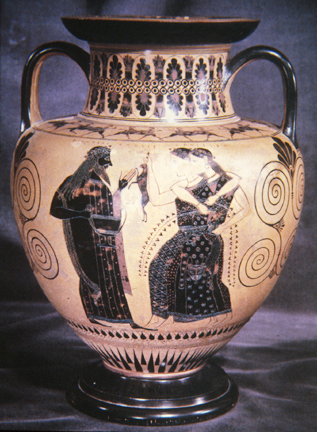Another of the most accomplished of the Greek vase painters was Amasis, who painted this beautiful amphora. Depicted here is an interaction between the god, Dionysis, and two of his acolytes, known as the Maenads. Dionysis is at left, and is elegantly attired in a flowing robe, and is shown with a beard and long hair, with a garland of grape leaves about his head. He, and the other figures, also stand along a baseline of stylized grape leaves. Note that he also carries a kantharos, a drinking vessel for wine. Dionysis was the god of fertility, vegetation, wine and ecstasy. He also was associated with death, rebirth, and immortality, since he was saved after having died by his father, the god Zeus. Zeus sewed his son into his thigh, where he grew into adulthood, emerging full grown, having been 'born' twice. This theme of the son of a god dying, and being reborn is, of course, a familiar one in later religions. Here we see the god Dionysis (later to be called Bacchus, by the Romans), in an encounter with two female figures, who, arm in arm, run towards the god, bringing an offering of a long eared rabbit. They also carry garlands of grape leaves and vines. Here is an interaction between a god and two humans. The women have no fear, and instead run towards the god in anticipation. They are also depicted the same size as the god. The implication here is that the gods are not removed from the human sphere, but rather, eagerly participate with humans in life. While the gods could certainly behave capriciously and even malevolently towards humans, what we see here is that the Greeks believed their gods to be intimately involved on a physical level with them. One maenad wears the skin of a spotted panther (or leopard), its head still attached. The name of Dionysis appears above his head, the maenads are also named above their heads, and between the two is the signature of the painter, Amasis, his name the same size and placement of the god! No hubris there. The Amasis painter is known for his skillful attention to the details of the clothing, the patterns in the fabrics, the hair styles, and for the use of the bold, spiral designs flanking the figures. Top each serial is a honeysuckle pattern, and the double honeysuckle is seen in the frieze at the neck of the amphora.
The rites of Dionysis were reported to have been quite raucous. Drinking and dancing, the maenads would become possessed by the spirit of Dionysis, and partake of a ritual meal, tearing meat from animals to eat, symbolizing the flesh of Dionysis. Men, dressed as satyrs (half man, half beast) would complete the picture. Orgiastic sex would follow, symbolizing their union with the god, helping them attain immortality.

Dionysis with Maenads, Black Figure Ware Amphora
Greek, 540 BCE


